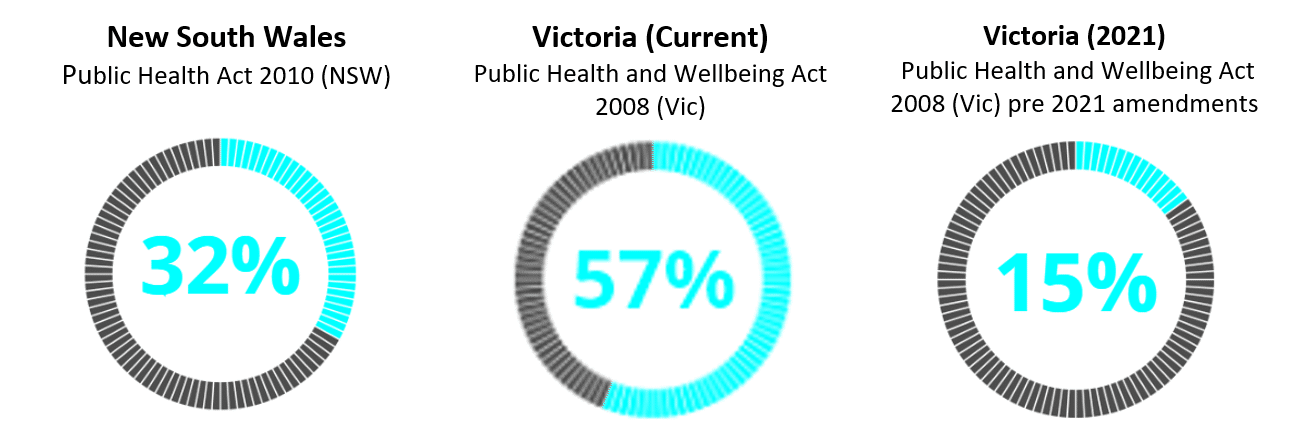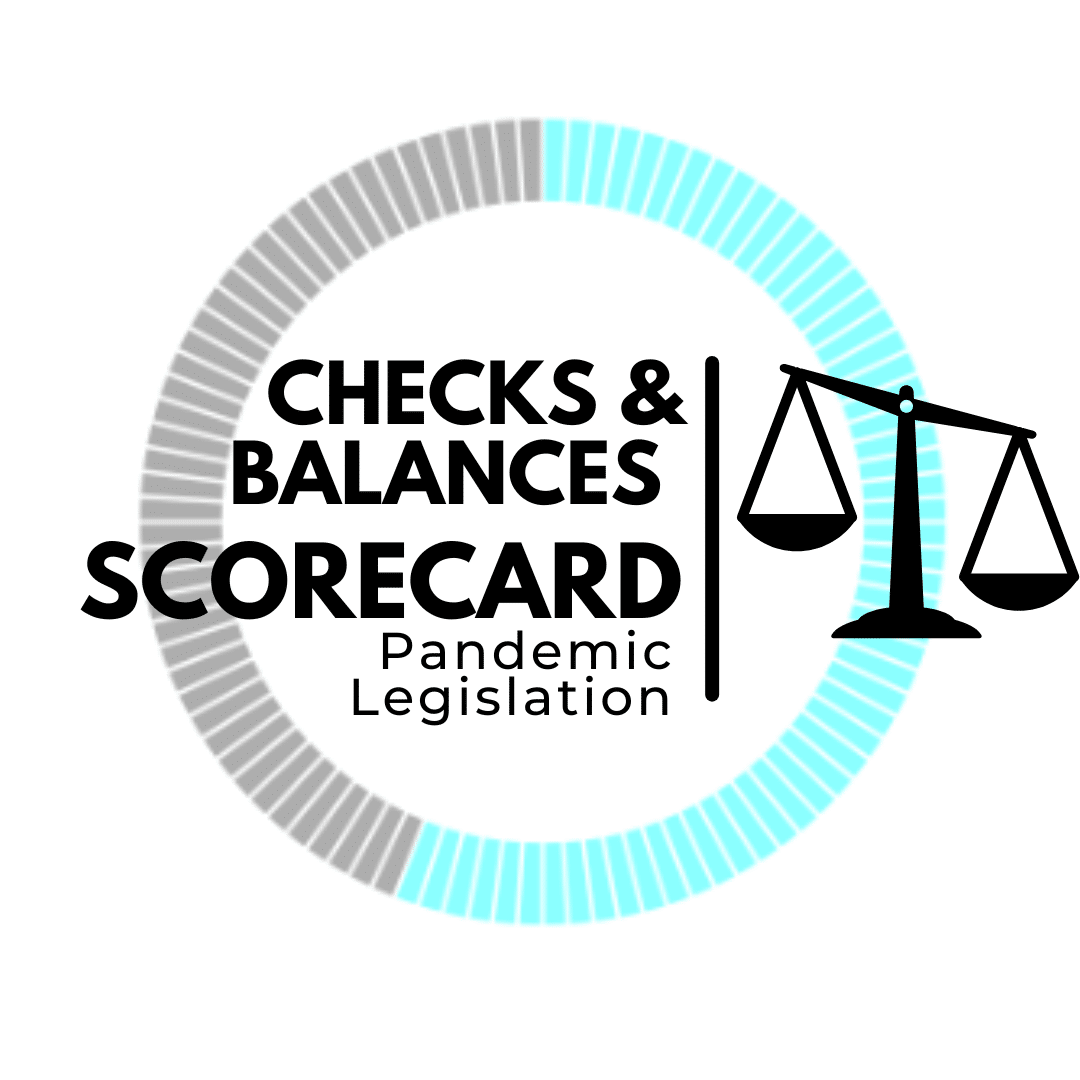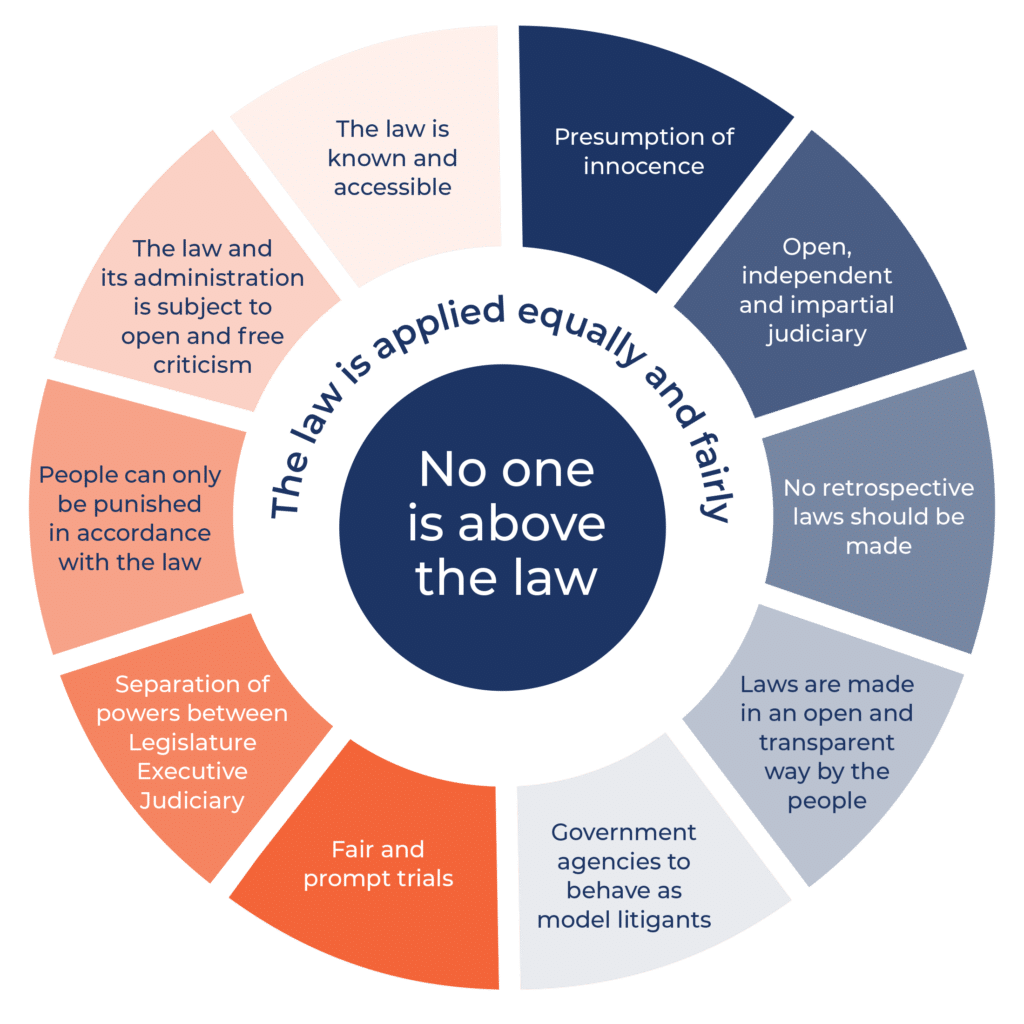Checks and Balances Scorecard: Pandemic Legislation
The Rule of Law Education Centre has developed the Checks and Balances Scorecard to measure the adequacy of oversight mechanisms in emergency laws that manage pandemics such as Covid- 19 (“Pandemic Legislation”). It is a broad indicator that uses objective and subjective factors to portray the extent of oversight, scrutiny and accountability in Pandemic Legislation.
The Scorecard is a compilation of 15 factors that consider the internal mechanisms, parliamentary oversight and external mechanisms within Pandemic Legislation to give a percentage score based upon the 15 factors considered. The higher the percentage, the greater the number of checks and balances contained within the Pandemic Legislation.
The Checks and Balances Scorecard for Pandemic Legislation has revealed the following stark comparison between New South Wales and Victorian legislation in place to deal with Covid-19:

On 26 October 2021, the Victorian Government introduced the Public Health and Wellbeing Amendment (Pandemic Management) Bill 2021 to amend the Public Health and Wellbeing Act 2008. The Bill received significant criticism, focusing on the need for checks and balances to be incorporated within the legislation where such extraordinary powers were being granted to the Government. Some amendments were made to the Bill, and it was passed on 07 December 2021. In the Second Reading Speech, it was stated that the Bill included “several major new mechanisms … to increase transparency in government decision-making during a pandemic” and “ensuring the legality and accountability of decisions made by Government.” Based on the Checks and Balances Scorecard, however, the Pandemic Legislation still lacks adequate oversight and scrutiny.
The Checks and Balances Score of 32% for New South Wales also highlights the urgent need for reform of the Public Health Act 2010 (NSW) with extraordinary powers still provided to the New South Wales Government without adequate checks and balances on the use of that power.
Details Regarding the Checks and Balances Scorecard
The Rule of Law Education Centre developed the conceptual framework of the Checks and Balances Scorecard by bringing together recommendations made by bodies such as the Australian Human Rights Commission, Victorian Bar Association, South Australian Law Society and the World Justice Project regarding preferable transparency and parliamentary oversight mechanisms that could be included in any legislation that deals with pandemic or emergency situations.
The Scorecard is based upon 3 broad categories, drawing upon those used by the World Justice Project Rule of Law Index, and includes 15 sub-factors.
The Rule of Law Education Centre reviewed the relevant Pandemic Legislation, together with recommendations made regarding those pieces of legislation and codified each sub-factor with the same value. The scores were aggregated for each sub-factor and converted into a percentage score.
The Checks and Balances Scorecard is designed to provide an indication of the quantity of checks and balances that have been incorporated within a piece of legislation. Once the sub-factors are aggregated it produces a Score to portray the extent of oversight, scrutiny and accountability for a specific Pandemic Legislation. In a similar way to the World Justice Project’s Rule of Law Index, this score allows for an easier comparison of different State and Territory Pandemic Legislation, as well as providing a measure of change for any amendments to the Pandemic Legislation.
However, the Checks and Balances Scorecard must be interpreted in light of certain inherent limitations including the codification of each sub-factor with the same value and the narrow focus on checks and balances to the exclusion of other important human rights and economic considerations. The Scorecard uses both objective and subjective measures and does not identify the specific priorities for reform but considers the many varied checks and balances that are included within the Pandemic Legislation to produce an individual score.
Categories used for the Checks and Balances Scorecard
Factor 1: Government Power limited by Internal Mechanisms
Internal mechanisms are needed to ensure that the person with ultimate responsibility to make Pandemic Orders is directly accountable to people at election time. They also provide checks and balances on the exercise of such powers. Factors to consider include:
1.1 Is the power to make a Health Order/Declaration held by someone (ie Member of Parliament) who is accountable to the electorate?
1.2 Is there a threshold to make a Health Order/Declaration that could be assessed against and objective standard that considers proportionate harm, inconvenience, and human rights?
1.3 Does a State of Emergency need to be in place before a Health Order/Declaration can be made and who decides the State of Emergency and on what basis?
1.4 Is there a limited scope for the Health Order/Declaration? Are there limits to the powers that a Health Order/Declaration can give to authorised officers? Will they be subject to adequate scrutiny and review?
1.5 Is there a time limit for Health Order/Declarations? Can they be rolled over and/or do they require Parliament to approve an extension?
Factor 2: Government Powers limited by Legislature
The legislative body review mechanism provides parliamentary supervision, scrutiny, and oversight of government powers. Factors to consider include:
2.1 Is there parliamentary approval for Emergency orders?
2.2 Are the Health Orders/Declarations disallowable? Do they rely on a government body to make a recommendation before they can be disallowed?
2.3 Is there a Parliamentary Committee Review? Will the findings be tabled in Parliament? Will the Parliament have the power to act on the recommendations of the review?
2.4 Is there a Contingency when Parliament is unable to sit, or a requirement for Parliament to meet before Health Orders/Declarations can be made?
Factor 3: Government Powers limited by Independent Review
External Review via non-government bodies provides transparency and accountability. Factors to consider include:
3.1 Is there a requirement to promptly publish Health Orders/Declarations?
3.2 Is there a requirement to publish reasons and evidence for the Health Orders/Declarations?
3.3 Is the Right to Protest protected?
3.4 Is Freedom of the Media/Speech protected?
3.5 Is there scrutiny by Subject Matter Experts and Community Representatives including Human Rights bodies and the Ombudsman?
3.6 Is the Right to a Fair trial protected? What about other rule of law principles such as the presumption of guilt or right to silence? Is there the ability to make complaints to an Independent Tribunal?
Further Reading:
Lorraine Finlay, ‘Submission to the Independent Review of Australia’s COVID Policy Response’, Australian Human Rights Commission (Web Page, 29 July 2022) < https://humanrights.gov.au/our-work/legal/submission/submission-independent-review-australias-covid-policy-response>
Boughey, J. (2020). Executive power in emergencies: Where is the accountability? Alternative Law Journal, 45(3), 168–174.
‘Explainer: Victoria’s proposed new pandemic law’ Human Rights Law Centre (Web Page, 10 November 2021) <https://www.hrlc.org.au/factsheets/2021/11/10/explainer-victorias-proposed-new-pandemic-law?
‘Daniel Andrews Pandemic Bill: The Attack on our Democracy’ Institute of Public Affairs (Web Page, November 2021) < https://ipa.org.au/publications-ipa/daniel-andrews-pandemic-bill-the-attack-on-our-democracy
‘Public Health and Wellbeing Amendment (Pandemic Management) Bill 2021 Second Reading Speech’ Victorian Legislation (Web Page, 16 November 2021) < https://www.legislation.vic.gov.au/bills/public-health-and-wellbeing-amendment-pandemic-management-bill-2021 >
‘Laws to manage COVID-19 and other pandemics must be transparent and proportionate’ The Law Society of South Australia (Web Page, 5 May 2022) <https://www.lawsocietysa.asn.au/Public/News_Media_Advocacy/MediaReleases/laws_to_manage_COVID.aspx>
‘What are Checks and Balances?’ Rule of Law Education Centre (Web Page, October 2021) < https://www.ruleoflaw.org.au/priorities/checks-and-balances/
‘Summary of Victorian Bar’s Submission to the Department of Health and Expert Reference Group on the Public Health and Wellbeing (Pandemic Management) Bill 2021’ Victorian Bar (Web Page, 9 November 2021) <https://www.vicbar.com.au/news-events/summary-victorian-bar%E2%80%99s-submission-department-health-and-expert-reference-group-public>
‘World Justice Project Rule of Law Index Factors’ World Justice Project (Web Page) <https://worldjusticeproject.org/rule-of-law-index/factors/2022>



